
Deadheading is the process of pruning away dead or wilted flowers from a plant. Deadheading the perennials in your garden is an important gardening chore because it:
- Increases the time span over which flowers bloom
- Increases the number of blooms on each plant
- Improves the appearance of the plant
- Reduces seed production in the flowers, which makes it easier for you to control how your garden will look
Table of Contents
How Deadheading Works
All perennials grow flowers that then die and produce seeds. When you deadhead spent, or wilted, flowers, you keep the plant from reaching the seed production stage and instead keep its energy focused on flower production.
When to Deadhead
While your garden is in bloom, make regular rounds inspecting the flowers. You should deadhead any bloom that has begun to fade and lose petals.
The Deadheading Process
The technique you should use to deadhead flowers on a perennial depends on the thickness of the plant’s stems and the way that the plant’s flowers are arranged on its stems. No matter how you deadhead, make sure to take off both the faded flower and the seed bud at the flower’s base.
Deadheading and Stem Thickness
You can deadhead plants with thin flower stems using just your fingers—pinch the stem between thumb and pointer finger at the point where you want to remove the stem.
For plants with thicker stems, you’re better off using gardening shears or hedge clippers.
If you’re not sure how to deadhead a particular type of plant in your garden, first try deadheading it using your fingers. If it’s easy for you to make a clean cut in the stem, then just keep deadheading with your fingers. If not, use shears or clippers instead.
Deadheading and Flower Arrangement
The best way to deadhead a plant also depends on how the plant’s flowers are arranged on its stems:
- Plants with a few stems, each with a single flower, above a base of foliage: Cut the entire stem down to the base of the foliage.
- Plants with multiple stems, each with one flower: Cut the stem back to the first set of leaves.
- Plants with multiple flowers on one stem: Deadhead just below each flower when it begins fade. When a stem no longer contains any flowers, cut the whole stem almost all the way to the ground.
- Plants that produce clusters of many flowers over a base of foliage: These plants produce so many flowers and stems that deadheading stem by stem would be too time-consuming. Instead, use a hedge clipper to cut away all the faded flowers at once.

